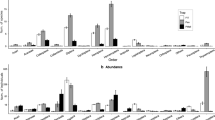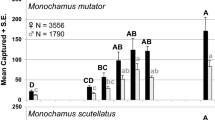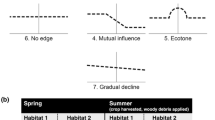Abstract
Studies of environmental gradients like edge effects commonly employ designs where samples are collected at unequal distances within transects. This approach risks confounding species patterns caused by the environmental gradient with patterns resulting from the spatial arrangement of the sampling scheme. Spatial autocorrelation and depletion (reduced catch) have the potential to influence pitfall-trap collections of invertebrates. Readily available control data from a study of edge and riparian effects on forest litter beetles was used to assess autocorrelation and depletion effects. Data from control transects distant from the treatment transects located at habitat edges and streams were screened to determine whether the study design (pitfall traps at varying distances within transects) was imposing patterns on the data attributable to differential autocorrelation or depletion. Autocorrelation in species composition and assemblage structure was not detected within the 99 m transects. The abundance and species richness of beetles were not lower where traps were in closer proximity, indicating that the transect design was not causing measurable depletion or resulting in differential trap catch. These findings indicate that spatial autocorrelation and depletion are unlikely to impair further analyses of edge and riparian effects on litter beetles.
Similar content being viewed by others
References
S.C. Baker A.M.M. Richarsdon O.D. Seeman L.A. Barmuta (2004) ArticleTitleDoes clearfell, burn and sow silviculture mimic the effect of wildfire? A field study and review using litter beetles For. Ecol. Manage. 199 433–448
S.E. Bedford M.B. Usher (1994) ArticleTitleDistribution of arthropod species across the margins of farm woodlands Agric. Ecosyst. Environ. 48 295–305 Occurrence Handle10.1016/0167-8809(94)90111-2
Briggs J.B. 1961. A comparison of pitfall trapping and soil sampling in assessing populations of two species of ground beetles (Col.: Carabidae). Report of East Malling Research Station for 1960, pp. 108–112.
D. Dalthorp (2004) ArticleTitleThe generalized linear model for spatial data: assessing the effects of environmental covariates on population density in the field Entomol. Exp. Appl. 111 117–131 Occurrence Handle10.1111/j.0013-8703.2004.00158.x
J.M. Dangerfield A.J. Pik D. Britton A. Holmes M. Gillings I. Oliver D. Briscoe A.J. Beattie (2003) ArticleTitlePatterns of invertebrate biodiversity across a natural edge Austral Ecol. 28 227–236 Occurrence Handle10.1046/j.1442-9993.2003.01240.x
K.F. Davies C.R. Margules J.F. Lawrence (2004) ArticleTitleA synergistic effect puts rare, specialized species at greater risk of extinction Ecology 85 265–271
A.C. Davison D.V. Hinkley (1997) Bootstrap Methods and Their Application Cambridge University Press Cambridge, UK
R.K. Didham P.M. Hammond J.H. Lawton P. Eggleton N.E. Stork (1998) ArticleTitleBeetle species responses to tropical forest fragmentation Ecol. Monogr. 68 295–323 Occurrence Handle10.2307/2657241
S.C. Digweed C.R. Currie H.A. Cárcamo J.R. Spence (1995) ArticleTitleDigging out the “digging-in effect” of pitfall traps: influences of depletion and disturbance on catches of ground beetles (Coleoptera: Carabidae) Pedobiologia 39 561–576
B.J. Downes L.A. Barmuta P.G. Fairweather D.P. Faith M.J. Keough P.S. Lake B.D. Mapstone G.P. Quinn (2002) Monitoring Ecological Impacts: Concepts and Practice in Flowing Waters Cambridge University Press Cambridge, UK
P.J.M. Greenslade (1964) ArticleTitlePitfall trapping as a method for studying populations of Carabidae (Coleoptera) J. Anim. Ecol. 33 301–310 Occurrence Handle10.2307/2632
P.J.M. Greenslade (1973) ArticleTitleSampling ants with pitfall traps: digging-in effects Insect. Soc. 20 343–353 Occurrence Handle10.1007/BF02226087
P. Greenslade P.J.M. Greenslade (1971) ArticleTitleThe use of baits and preservatives in pitfall traps J. Aust. Ent. Soc. 10 253–260
T.H. Keitt O.N. Bjornstad P.M. Dixon S. Citron-Pousty (2002) ArticleTitleAccounting for spatial pattern when modeling organism–environment interactions Ecography 25 616–625 Occurrence Handle10.1034/j.1600-0587.2002.250509.x
D.J. Kotze M.J. Samways (2001) ArticleTitleNo general edge effects for invertebrates at Afromontane forest/grassland ecotones Biodivers. Conserv. 10 443–466 Occurrence Handle10.1023/A:1016606209906
P. Legendre (1993) ArticleTitleSpatial autocorrelation: trouble or new paradigm? Ecology 74 1659–1673 Occurrence Handle10.2307/1939924
M. Leponce L. Theunis J.H.C. Delabie Y. Roisin (2004) ArticleTitleScale dependence of diversity measures in a leaf-litter ant assemblage Ecography 27 253–267 Occurrence Handle10.1111/j.0906-7590.2004.03715.x
M.L. Luff (1968) ArticleTitleSome effects of formalin on the numbers of Coleoptera caught in pitfall traps Entomol. Mon. Mag. 104 115–116
M.L. Luff (1975) ArticleTitleSome features influencing the efficiency of pitfall traps Oecologia 19 345–357
A.E. Magurran (2004) Measuring Biological Diversity Blackwell Malden, MA
B.A. Melbourne (1999) ArticleTitleBias in the effect of habitat structure on pitfall traps: an experimental evaluation Aust. J. Ecol. 24 228–239 Occurrence Handle10.1046/j.1442-9993.1999.00967.x
J. Niemelä (1990) Spatial distribution of carabid beetles in the southern Finnish taiga: the question of scale N.E. Stork (Eds) The Role of Ground Beetles in Ecological and Environmental Studies Intercept Hampshire, UK 143–155
J. Niemelä Y. Haila P. Puntilla (1996) ArticleTitleThe importance of small-scale heterogeneity in boreal forests: variation in diversity in forest-floor invertebrates across the succession gradient Ecography 19 352–368 Occurrence Handle10.1111/j.1600-0587.1996.tb00246.x
Oksanen J. 2004. Vegan: community ecology package. R package version 1.6–4.
J. Perner S. Schueler (2004) ArticleTitleEstimating the density of ground-dwelling arthropods with pitfall traps using a nested-cross array J. Anim. Ecol. 73 469–477 Occurrence Handle10.1111/j.0021-8790.2004.00821.x
InstitutionalAuthorNameR Development Core Team (2003) R: a language and environment for statistical computing R Foundation for Statistical Computing Vienna, Austria
L.K. Rieske L.J. Buss (2001) ArticleTitleInfluence of site on diversity and abundance of ground- and litter-dwelling Coleoptera in Appalachian oak-hickory forests Environ. Entomol. 30 484–494 Occurrence Handle10.1603/0046-225X-30.3.484
R.A. Sanderson S.P. Rushton A.J. Cherril J.P. Byrne (1995) ArticleTitleSoil, vegetation and space: an analysis of their effects on the invertebrate communities of a moorland in north-east England J. Appl. Ecol. 32 506–518 Occurrence Handle10.2307/2404648
J.R. Spence J.K. Niemelä (1994) ArticleTitleSampling carabid beetle assemblages with pitfall traps: the madness in the method Can. Entomol. 126 881–894
H.H. Wagner (2004) ArticleTitleDirect multi-scale ordination with canonical correspondence analysis Ecology 85 342–351
D.F. Ward T.R. New A.L. Yen (2001) ArticleTitleEffects of pitfall trap spacing on the abundancerichness and composition of invertebrate catches J. Insect Conserv. 5 47–53 Occurrence Handle10.1023/A:1011317423622
A.H. Welsh R.B. Cunningham C.F. Donnelley D.B. Lindenmayer (1996) ArticleTitleModelling abundance of rare species: statistical models for counts with extra zeros Ecol. Model. 88 297–308 Occurrence Handle10.1016/0304-3800(95)00113-1
Author information
Authors and Affiliations
Rights and permissions
About this article
Cite this article
Baker, S.C., Barmuta, L.A. Evaluating spatial autocorrelation and depletion in pitfall-trap studies of environmental gradients. J Insect Conserv 10, 269–276 (2006). https://doi.org/10.1007/s10841-006-0016-8
Received:
Accepted:
Issue Date:
DOI: https://doi.org/10.1007/s10841-006-0016-8




